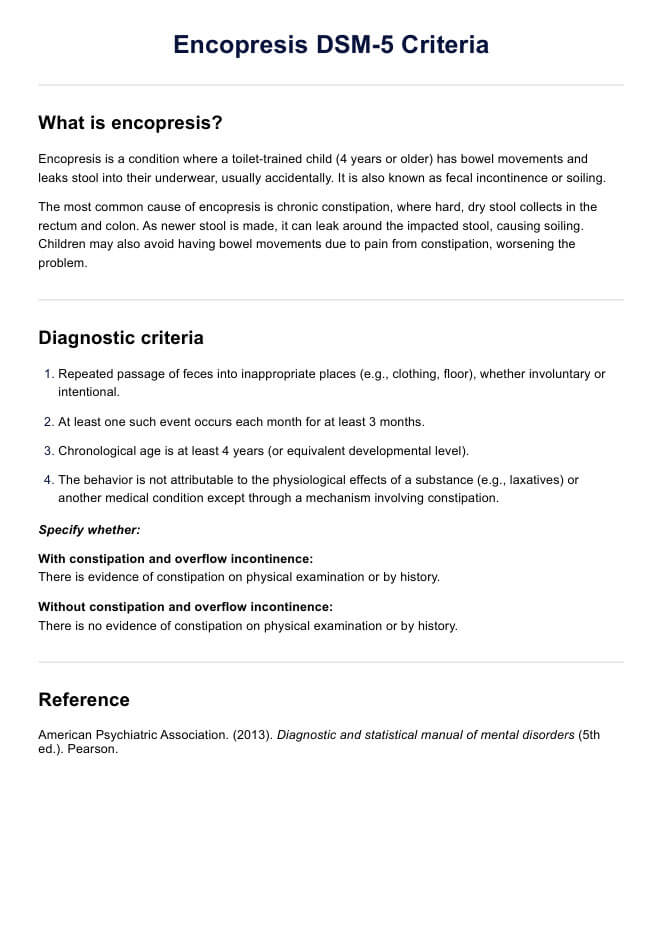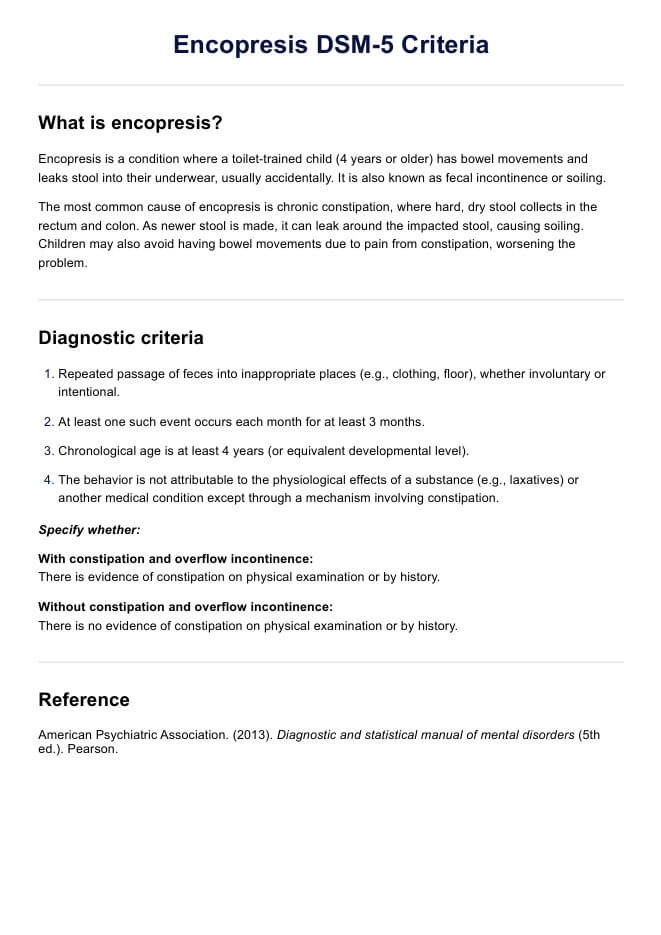Encopresis DSM-5 Criteria
Download our Encopresis DSM-5 Criteria as a reference tool when working with clients who present symptoms of elimination disorders.


What is encopresis?
Encopresis is an elimination disorder characterized by the repeated passage of feces into inappropriate places, such as clothing or floor, in children aged 4 years or older. It can be either involuntary or intentional and must occur at least once a month for three months (American Psychiatric Association, 2013a).
Often associated with chronic constipation and overflow incontinence, this form of fecal incontinence can significantly impact a child's social and emotional well-being. It's important to note that the behavior is not solely attributable to another medical condition or substance use, except through mechanisms involving constipation.
Encopresis DSM-5 Criteria Template
Encopresis DSM-5 Criteria Sample
How is encopresis diagnosed?
Diagnosing encopresis involves a comprehensive approach that combines clinical assessment, physical examination, and patient history.
A thorough evaluation typically includes:
- Detailed patient history: Focusing on controlling bowel movements, toilet training experiences, and any associated pain or discomfort.
- Physical examination: Including abdominal and rectal examinations to identify potential physical issues or complications.
- Psychological assessment: To evaluate for comorbid mental health conditions often associated with encopresis.
- Differential diagnosis: Ruling out other medical conditions that could explain the symptoms.
It's crucial to distinguish between the two subtypes of encopresis: with and without constipation and overflow incontinence. This differentiation guides treatment approaches.
Healthcare providers should also consider the child's developmental and mental age and any cultural factors that might influence toilet training practices or attitudes towards elimination. A sensitive, non-judgmental approach is essential throughout the diagnostic process to ensure accurate information gathering and to build trust with the child and family.
Encopresis DSM-5 diagnostic criteria
The Diagnostic and Statistical Manual of Mental Disorders, Fifth Edition (DSM-5) provides clear criteria for diagnosing encopresis. These criteria help ensure consistent diagnosis across healthcare settings and guide appropriate treatment planning. According to the DSM-5 (American Psychiatric Association, 2013a), the diagnostic criteria for encopresis are:
- Repeated passage of feces into inappropriate places (e.g., clothing, floor), whether involuntary or intentional.
- At least one such event occurs each month for at least 3 months.
- Chronological age is at least 4 years (or equivalent developmental level).
- The behavior is not attributable to the physiological effects of a substance (e.g., laxatives) or another medical condition except through a mechanism involving constipation.
It's also important to note that the DSM-5 recognizes two subtypes of encopresis:
- With constipation and overflow incontinence
- Without constipation and overflow incontinence
Differences between the DSM-4 and DSM-5 criteria
The transition from DSM-IV to DSM-5 brought minimal alterations to the diagnostic criteria for elimination disorders. While these conditions were previously categorized under disorders usually first diagnosed in infancy, childhood, or adolescence in DSM-IV, they now stand as a distinct classification in DSM-5. This reclassification maintains the integrity of the diagnostic criteria while emphasizing the unique nature of elimination disorders across the lifespan (American Psychiatric Association, 2013b).
Other disorders associated with encopresis
Encopresis often co-occurs with other behavioral and elimination disorders, complicating both diagnosis and treatment. Understanding these associations is crucial for comprehensive patient care.
The following disorders are commonly associated with encopresis:
- Oppositional defiant disorder (ODD): Children with ODD exhibit persistent patterns of angry, irritable mood and defiant, argumentative behavior. In the context of encopresis, this may manifest as refusal to follow toileting routines or resistance to treatment strategies.
- Conduct disorder (CD): CD involves more severe behavioral problems, including aggression, destruction of property, and serious violations of rules. Children with both CD and encopresis may have more complex treatment needs due to the severity of their behavioral issues.
- Urinary incontinence: Children with encopresis may also experience daytime wetting and nocturnal enuresis (bedwetting).
- Attention-deficit/hyperactivity disorder (ADHD): ADHD is characterized by inattention, hyperactivity, and impulsivity. Children with ADHD may have difficulty recognizing and responding to bodily cues related to bowel movements, potentially exacerbating encopresis symptoms.
- Anxiety disorders: Anxiety can contribute to stool withholding behaviors and make it more challenging for children to relax during bowel movements. This can create a cycle that worsens encopresis symptoms.
How is encopresis treated and managed?
Treating and managing encopresis typically involves a multidisciplinary approach, addressing both the physical and psychological aspects of the condition. The primary goals are to establish regular bowel movements, prevent constipation, and modify toileting behaviors. This often involves the following:
Medical management
Treating encopresis often begins with addressing any underlying constipation. This typically involves a bowel cleanout using laxatives or enemas to remove impacted stool, followed by maintenance therapy with stool softeners or laxatives to prevent constipation recurrence. The goal is to establish regular, comfortable bowel movements and break the cycle of constipation and withholding.
Behavioral interventions
A crucial component of encopresis treatment is implementing behavioral strategies. This includes establishing a regular toilet routine, often using positive reinforcement techniques. Children are typically encouraged to sit on the toilet for 5-10 minutes after meals to take advantage of the gastrocolic reflex. Dietary modifications, such as increasing fiber and fluid intake, are also recommended to promote softer stools and regular bowel movements
Psychosocial support
Addressing the emotional aspects of encopresis is vital for successful treatment. This involves educating the family about the condition and its management, helping to reduce blame and shame. Counseling may be beneficial for children experiencing anxiety, low self-esteem, or social difficulties related to their condition. Family therapy can also be helpful in addressing any family dynamics that may be contributing to the problem.
Biofeedback and additional therapies
In some cases, biofeedback training can help children learn to relax their pelvic floor muscles especially when experiencing painful defecation, improving their ability to pass stool effectively. Other therapies, such as pelvic floor physical therapy, may be considered in complex cases or when standard treatments have been unsuccessful.
References
American Psychiatric Association. (2013a). Diagnostic and statistical manual of mental disorders (5th ed.). Pearson.
American Psychiatric Association. (2013b). Highlights of changes from DSM-IV-TR to DSM-5. American Psychiatric Association. https://www.psychiatry.org/File%20Library/Psychiatrists/Practice/DSM/APA_DSM_Changes_from_DSM-IV-TR_-to_DSM-5.pdf
Commonly asked questions
The most common cause of encopresis is chronic constipation. When a child experiences constipation, it becomes difficult to have regular bowel movements because the stool hardens in the colon. This leads to stool withholding, impaction, and eventually overflow incontinence, causing the child to leak stool into their underwear.
The ICD-10 code for encopresis is F98.1.
The duration of encopresis can vary. If properly treated, most children with encopresis can overcome the condition. However, without treatment, encopresis can persist for many years. Children may still have occasional accidents and soil their underwear from time to time until the intestine and rectum regain their normal muscle tone.





















-template.jpg)


















































































